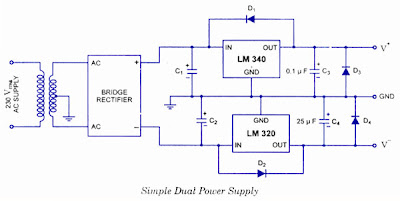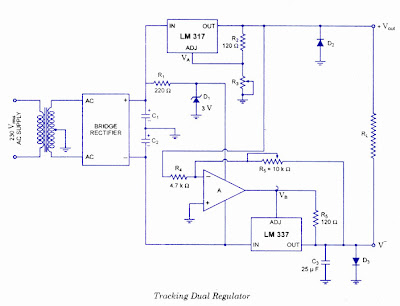
Number of signs needed and bipolar integrated circuits (double V ± o) supplies. This can be done easily with two three-terminal regulators, as illustrated in Fig. Faced with the CA phase is provided by the transformer secondary and a center tap to ground. The only full-wave bridge converts these into positive and negative voltages (with respect to the center tap to ground). Filtration (to ground) is provided by the capacitors C1 and C2.
The LM 340 provides positive voltage regulation, while the LM 320 regulates the negative voltage. It is very important to mention that LM 320 has a pin configuration different from the LM 340. The case of the 320 LM is not a field. So care must be taken while mounting the negative regulator.
Diodes provide protection, but make sure you are not invested. Diodes DI and D2 ensure that transients in the outputs of the controller output does not lead to a potential above its inputs and cause damage to the regulators. Furthermore, the two regulators are not activated simultaneously. If this occurs, the controller output can be driven slowly to the potential of the fastest. The diodes D3 and D4 prevent these reversed polarity at startup.

Many applications require many different sources of energy supply. One solution is the construction of several independent regulators. However, very often, it is important that all these voltages track. That is, if one of the voltages up 2%, it is best that all voltages are on the same amount. Can be achieved by adding an op amp voltage regulator for three-terminal adjustable.
The circuit of the figure provides a close current limiting and thermal for negative and positive output voltage. The positive voltage regulator produces an adjustable positive regulator LM 317 IC, as it was in the figure.
The positive sign is always regulated 1.2 V more positive than the voltage across R3 (on pin adjustment). This output voltage is used as the input of an inverting amplifier. The amplifier A is the input stage of this amplifier, and voltage regulator LM 337 negative is the power output stage. Consequently, the negative regulated output voltage V "is amplified and inverted version of the regulated positive voltage V +. Current limiting and thermal shutdown are independently provided by the LM 317 (for the positive output) and LM 337 (to output negative). The operational amplifier ensures that the negative output voltage tracks the positive output from the conduct of the LM 337 adjust pin to + 1.2 V above the negative output required. Given the LM 337 is within the negative feedback loop of operational amplifier, this offset + 1.2 V appears between the amplifier and the regulator, not the regulator output.
The circuit of the figure provides a close current limiting and thermal for negative and positive output voltage. The positive voltage regulator produces an adjustable positive regulator LM 317 IC, as it was in the figure.
The positive sign is always regulated 1.2 V more positive than the voltage across R3 (on pin adjustment). This output voltage is used as the input of an inverting amplifier. The amplifier A is the input stage of this amplifier, and voltage regulator LM 337 negative is the power output stage. Consequently, the negative regulated output voltage V "is amplified and inverted version of the regulated positive voltage V +. Current limiting and thermal shutdown are independently provided by the LM 317 (for the positive output) and LM 337 (to output negative). The operational amplifier ensures that the negative output voltage tracks the positive output from the conduct of the LM 337 adjust pin to + 1.2 V above the negative output required. Given the LM 337 is within the negative feedback loop of operational amplifier, this offset + 1.2 V appears between the amplifier and the regulator, not the regulator output.